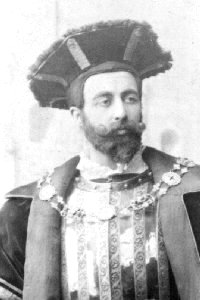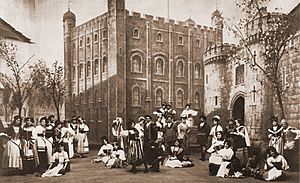Richard Cholmondeley facts for kids

Sir Richard Cholmeley (around 1460–1521) was an English soldier and farmer. He worked as the Lieutenant of the Tower of London from 1513 to 1520, during the time of King Henry VIII.
People remember him for his tomb at the Tower of London. He is also a character in the famous Gilbert and Sullivan comic opera, The Yeomen of the Guard. His name is often spelled "Cholmondeley" because of a mistake on his tomb's plaque. This led to the character in the opera having the wrong spelling too. Other parts of his family did use the longer "Cholmondeley" spelling.
Sir Richard became a knight in 1497 for being brave in a battle against the Scots. He kept serving as a soldier until 1513. He was trusted with many important jobs, looking after castles and forts in England. He was also a good farmer and smart with money, buying lots of land. This made his family much richer.
As Lieutenant of the Tower, he faced some criticism. This happened during the Evil May Day riots in 1517. He ordered the Tower's cannons to fire at the city to stop the rioting. He also helped rebuild the chapel of St Peter ad Vincula at the Tower. His son, Roger Cholmeley, who was born outside of marriage, later became a very important judge.
Contents
Who Was Sir Richard Cholmeley?
Richard Cholmeley (pronounced "Chumley") was born in Chorley, Cheshire. This small place is near Nantwich and Cholmondeley. He was the oldest son of Joan Eyton and John Cholmeley. His parents were rich sheep farmers and owned a lot of land. When Richard was very young, his family moved to East Yorkshire. His mother's father owned many large estates there.
Early Life and Adventures
In 1492, Cholmeley became the Bailiff of York. Then, in 1495, he was made High Sheriff of Northumberland. In 1497, he served under Thomas Howard, Earl of Surrey. They fought back a Scottish attack at Norham Castle. This castle was a strong place for the Bishop of Durham.
Because of his brave service, Cholmeley was made a knight. Lord Surrey knighted him on the battlefield at Ayton. In the same year, he became Lieutenant of Berwick upon Tweed. He also became Governor of Kingston upon Hull. In 1499, Cholmeley and his younger brother Roger became Constables of Pickering Castle. They also became Stewards and Foresters of the Royal Forest. Sir Richard bought a small home nearby at Thornton on the Hill. In 1506, Cholmeley was put in charge of collecting taxes in the Port of London.
In 1513, the Scots attacked England. They were helping France because of an old agreement. At the Battle of Flodden, the English army won. Cholmeley led soldiers from Cheshire in this battle. He also brought the citizen soldiers from Hull. After the English victory, Lord Surrey was given back his title as Duke of Norfolk.
Guarding the Tower of London
In October 1513, Cholmeley was chosen to be the Lieutenant of the Tower of London. He also oversaw Richmond Castle and eleven other castles in Yorkshire. There was no good house for his family inside the Tower. So, he bought a house in nearby Barking. He lived there while working at the Tower.
The Lieutenant worked under the Constable of the Tower. At that time, this was Thomas Lovell. The Lieutenant's jobs included defending the Tower. He also had to keep it in good repair. He was in charge of the prisoners there. This included taking important prisoners to trials at Westminster Hall. This hall was where the courts of law were held back then.
Cholmeley also worked on repairing the Tower. He completely rebuilt the chapel of St Peter ad Vincula. This church was for the Tower of London area. A fire had badly damaged it in 1512. The rebuilding work happened in 1519 and 1520.
Cholmeley lost some support from the City of London leaders. This was because of how he reacted to the Evil May Day riots in 1517. During these riots, young Londoners attacked foreigners. They especially targeted rich foreign merchants and bankers. These gangs took control of London for several days. Cholmeley angrily ordered some of the Tower's cannons to fire at the city. This made the city's older leaders very upset.
In 1520, he left his job at the Tower because he was ill. He passed away in March 1521 in St Katharine's by the Tower.
Cholmeley is the only real historical person to appear in a Gilbert and Sullivan opera. This opera is called The Yeomen of the Guard. In the story, while he is Lieutenant of the Tower, Cholmeley finds that a main prisoner has escaped. This prisoner was supposed to be executed. Cholmeley then starts a big search.
His Legacy and Family
Cholmeley became very rich. He inherited money and was smart about buying property. When he died, he owned many large estates. These were in places like Northumberland, Cumberland, Yorkshire, and London. In his will, dated December 26, 1521, he left most of his wealth to his wife, Elizabeth. He also left gifts to his only child, his son Roger, who was born outside of marriage. Cholmeley also left special items to his younger brother, who was also named Roger.
Cholmeley's wife, Elizabeth, later married a third time. Her new husband was Sir William Gascoigne. She passed away in 1546. His son, Roger Cholmeley, started studying law in 1506. He became a judge for the City of London. He was also a member of parliament and a chief judge. He was knighted in 1534. In 1552, he became the Chief Justice of the King's Bench. He was only a chief judge for one year. This was because Queen Mary I did not reappoint him.
Also in 1552, he was put in the Tower of London for six weeks. He was fined for signing a document that named Lady Jane Grey as Queen. He went back to work as a lawyer. Roger died in 1565, leaving behind two daughters. He is best remembered for starting a free school in London, called Highgate School.
Cholmeley's brother, Roger, had a son also named Richard. This Richard's family line includes the Cholmeleys of Roxby and Whitby. This is the family line of the current 7th Baronet, Sir Frederick Sebastian Cholmeley. Cholmeley's cousin, Richard Cholmondeley, was married to Elizabeth Brereton. Her brother, William Brereton, was executed in 1536. He was suspected of being a lover of Anne Boleyn. That part of the family, starting with Sir Hugh Cholmondeley, included the Marquesses and Earls of Cholmondeley.
The Mystery of His Name
After the chapel of St. Peter ad Vincula was rebuilt in 1522, a tomb was placed there. It had statues of Cholmeley and his wife on top. This monument is one of the oldest in the chapel. Many famous people who were executed at the Tower are buried there. The white stone statues lie under an iron fence in the middle of the church.
However, Cholmeley is not actually buried in this tomb. In his will, he asked to be buried "within the Chapel of our blessed Lady of Barking beside the Tower of London." This church is now called "All Hallows, Barking." If that was not possible, he wanted to be buried in the "Church of the Crutched Friars beside the Tower of London." This church is now called "St. Olaf's." All Hallows was almost completely destroyed during World War II bombings. So, it is not known if he was buried there or at St. Olaf's. Some clues suggest he might have been buried in a tomb of the Cholmondeley family branch.
Cholmeley's family can be traced back to the 1100s. Robert de Chelmundelegh was the second son of William le Belward. He inherited parts of the Malpas area, including Cholmondeley, Cheshire. Over hundreds of years, the family name was spelled in many different ways. This happened as the English language changed. Different parts of the family spell the name differently. Cholmeley's most famous cousins, from Cholmondeley, Cheshire, spell the name "Cholmondeley."
In Victorian times, Sir Richard's tomb in St. Peter ad Vincula was moved. A new name plate was put on it. This plate said the Lieutenant of the Tower was named Richard "Cholmondeley." This is why Gilbert and Sullivan called him "Sir Richard Cholmondeley" in their opera. However, Sir Richard's father was John Cholmeley. His grandfather was William Cholmeley, and his brother was Roger Cholmeley. His will is signed Richard Cholmeley, and his son was Sir Roger Cholmeley. After the Cholmondeley branch of the family became more famous, Sir Richard Cholmeley, the Lieutenant of the Tower, was confused with his cousin, Richard Cholmondeley of Cholmondeley, Cheshire. He was also confused with other knights named Richard Cholmondeley or Cholmeley who lived around the same time.


